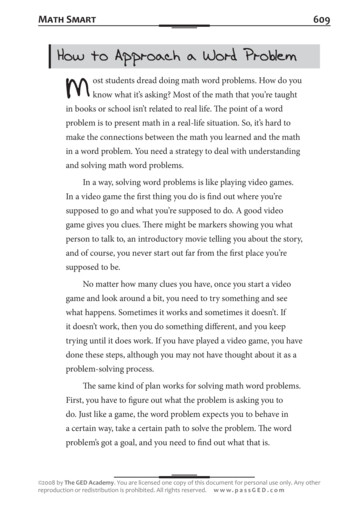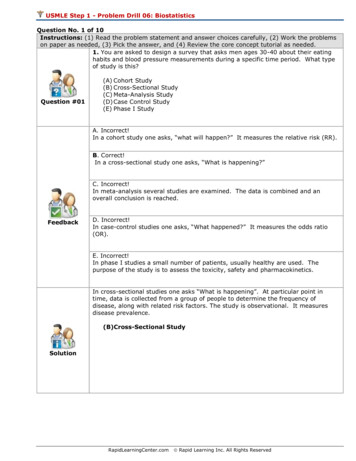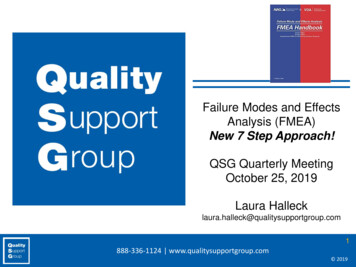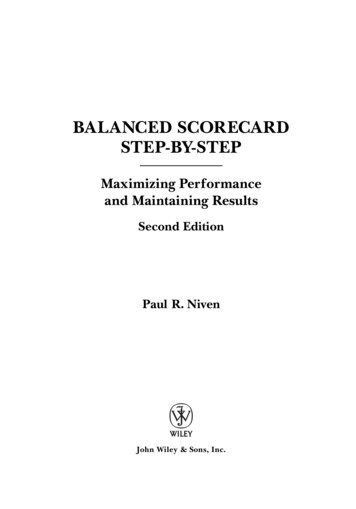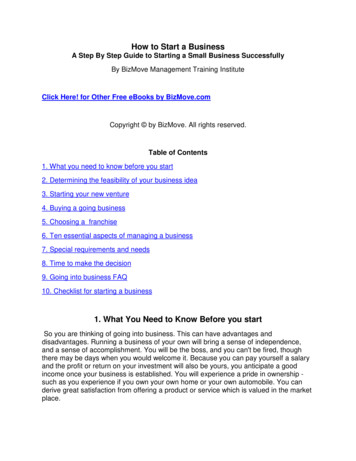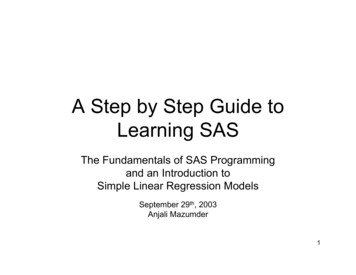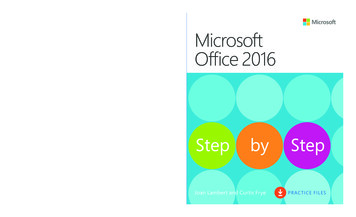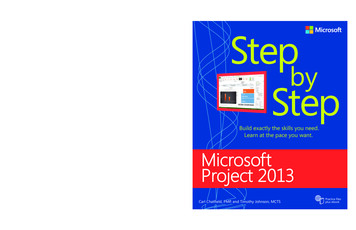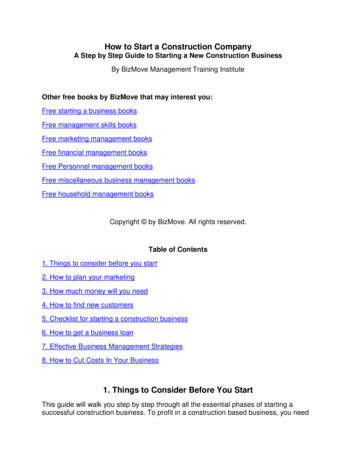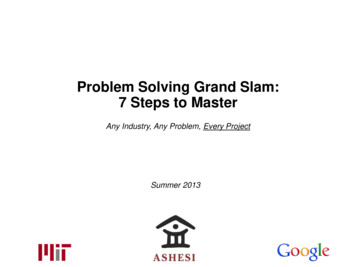
Transcription
Problem Solving Grand Slam:7 Steps to MasterAny Industry, Any Problem, Every ProjectSummer 2013
The 7-Steps to master problem solvingWeekly cycle1357DefineproblemWriteStoryline andGhost packGather Dataand AnalyseCriticallyBuildCommitment2Build IssueTree Problemstatementsshouldcommence witha question or afirm hypothesis Be specific,actionable andfocus on whatthe decisionmaker needs tomove forward Break aproblem intocomponentparts so thatproblems canbe divided andallocated The partsshould be MECE Do it as a team,share withExperts andclient to getinput andalignment4DevelopWorkplan Write your bestversion of theanswer to theproject –STORYLINE Develop ghostpack thatsupports thisStoryline Prioritise keyissues andeliminate nonessential issues A workplan isnot just a Ganttchart, it muststate the: Issue Hypotheses Analysis(frameworks,process etc) Sources Who isresponsible Timing End product Review cycles6Synthesizeand So What Be hypothesisand endproductoriented Start with orderof magnitude “Porpoise”betweenhypothesis anddata Keep theanalyses simple Be flexible inthe face of newdata Be creative Drive to end ofweek answer Tool #1:EmploySituationObservationImplicationframework Tool #2:Follow pyramidstorylinestructure Pass the 3 SoWhats Follow aCommunicationPlan (T-5, T-2,etc) Validate,validate,validate – closeto your enemies Have the extrapage in yourback pocketEngage Clients, Stakeholders & Experts7-step approach to problem solving2
Weekly cycle13DefineproblemPrioritise &WriteGhostpackWhy hypothesis-based approach?2Build IssueTree457GatherData ynthesize& IterateDeductive Analysis Approach (found in most client organisations)Extensive Data CollectionConclusions &RecommendationsData Analysis1.2.Inductive Analysis Approach (used in Phase 1)HypothesesAreas forimprovementscould be:AnalysisUse a range of specificdiagnostics to testhypothesesResultsT/FConclusions &Recommendations1.Speed,Effort, Risk &StakeholderEngagement2.time7-step approach to problem solving3
13DefineproblemPrioritise &WriteGhostpackDefine problem2Build IssueTreeWeekly cycle45GatherData Synthesize& IterateEvaluationX bank is losing money on broker introduced business andneeds a plan to fix itStatement of factHow should X bank restructure its broker relationships tomake better returnsNot disputable and toogeneralWhat set and sequence of initiatives should X bankimplement to cement its more profitable broker relationshipsand to change the laws of remunerating the larger numberof unprofitable relationships?Specific, actionable7-step approach to problem solving4
Gaining an accurate understanding of the problem is thefirst priority7-step approach to problem solving5
Clear documentation of the problem is equally important7-step approach to problem solving6
Build the logic/issue treeLogic/Issue TreeSub-issueIssues ues /Hypothesis#2Sub-issueSub-issueIssues /Hypothesis#3Sub-issue13DefineproblemPrioritise &WriteGhostpack2Build IssueTreeWeekly cycle4DevelopWorkplan5GatherData &AnalyseCritically76BuildCommitmentSynthesize& IterateWhy use logic or issue trees?1. To break a problem into component parts sothat: Problem solving work can be divided intointellectually manageable pieces Priorities can be set between the parts Responsibilities can be allocated toindividuals2. To ensure that the integrity of the problemsolving is maintained Solving the parts will really solve theproblem The parts are mutually exclusive andcollectively exhaustive (ie. No overlaps,no gaps)3. To build a common understanding within theteam of the problem solving framework4. To help focus use of organising frameworksand theories7-step approach to problem solving7
13DefineproblemPrioritise &WriteGhostpackThree types of logic/issue treeType of TreeDeductiveDescriptionStarts with problem definitionand divides it into components2Build IssueTreeWeekly cycle4DevelopWorkplanElementsin Splits5GatherData &AnalyseCritically76BuildCommitmentSynthesize& IterateWhen to UseActions,assertions,questions,categories Early on, when youdon’t know muchOR When mathematicalcompleteness isimportant(eg. ROIC Trees)Hypothesis DrivenPostulates a solution hypothesisand develops a necessary andsufficient rationale to validate ordisprove itReasons /Questions At any point in theprocessIssue MapPhrases key issues so that theycan be answered yes or no, andsequence them in a logical ordershowing the dependent actionQuestions Use issue maps toframe options,usually later in theprocess7-step approach to problem solving8
13DefineproblemPrioritise &WriteGhostpackThere are many ways to disaggregatea problemProcessFlow-Out2Build IssueTreeWeekly cycle45GatherData erials76BuildCommitmentSynthesize& IterateLayBricksHorizontalCharacteristicsSuitable bricksProperly mixed mortarVerticalCharacteristicsCriteriaSkilled labourGood weather7-step approach to problem solving9
Logic tree tips13DefineproblemPrioritise &WriteGhostpack2Weekly cycleBuild IssueTreePrinciple457GatherData ynthesize& IterateWhy Use your whole team, not lone wolf approach Rough and tumble hypothesis sessions tap everyone’screativity, tend to get better answers and are fun If stuck, try building them backward (from the ‘twigs’) inaddition to forward (from the ‘trunk’’) It is sometimes easier to think up sub-issues andanalysis and then to group them, than to work linearly Try multiple trees and constantly update and revise Different trees provide new perspectives on theproblem Use frameworks to guide your questions Leverages previous experienceRules to followHypotheses are statements that: identify a client organisation's weakness, gap oropportunity we believe are likely to be true are (sometimes) based on our knowledge of the client’sindustry can be validated or refuted by analysis during the Phase 1 if validated, are likely to represent a significant businesscase element can be translated into project streams for Phase 2How to get our thinking goingWhat is the issue? What is not working? Where is the process broken? x is notoptimal What do you think is causing the problem? What are the key drivers due to of the issue?What is the effect? Why do we care? Where is the opportunity? resultingin 7-step approach to problem solving10
13DefineproblemPrioritise &WriteGhostpackCreate a ghost packHeadline (top line on each powerpoint slide)2Build IssueTreeThe Payments Transformation program is delivering to its originalplanResults from the vendor gap assessment and initial architecturedesign suggests the cost to implement would exceed originalestimateWe intend to work harder to make the Fundtech/SOA solution fitthe original budget To date, the business justification for payments transformation iscentered on “unraveling the spaghetti to deliver systemsrobustness”We haven’t yet told you about the other half of the story theambition of delivering a truly transformational program forcustomers, shareholders and employeesOur vision is to be ahead of the game by 2017 deliver a richer set of functional capabilities to enrich customerexperience, increase value to them, thereby earn heir “stickiness” increase our capability to serve the specific needs of differentsegments Content (of each slide)Diagram showing progress of work including Hub I andvendor gap assessment (June?)Gap assessment (June?)TIBCO diagram (David?) Analysis showing “how” at a conceptual level (David?)Perhaps a portfolio approach it IT assets?Use the old spaghetti diagram turning into the SOAconstruct in 2 stages (Ed?) Schematic showing what we mean by more value to thethree stakeholder groups (Ed coordinate input from Paul,James and Roger?)Framework to rate Westpac against other banks (now andin the future) – James/Ed?Current vs futureOverview of functional limits todayPicture of the end-state in terms of functionality (June?)Value added services? reduce total cost of ownership by reducing errors and adopting a portfolio approach to systems replacement align the scale of IT against customer segment need locate functions in the right geographies (in terms of cost and capability compliance? systems robustness? straight through processing, tracking capability? SOA Our strategy is to better utilize Westpac investment budget Our roadmap to get there Current vs futureModular product set specific to each segment, channelaccess, information? (Paul?)Current vs future (Roger/Phil/Ed?)Current vs futureDavid?Current vs futureEd/James?Current vs futureJune?Current vs futureDavid?David?David? 50m used to used on technology 43m on otherWe need to be more specific hereAlign each work package with deliverables and outcomesto WestpacDefine this in terms of customer experience andshareholder valueInclude Hub 1, DE remediation to give sense of progressWeekly cycle4DevelopWorkplan5GatherData &AnalyseCritically76BuildCommitmentSynthesize& IterateWhy create ghost pack whenyou haven’t even startedlooking at the data?1. Enables you/your team tobe output oriented2. Forces you to think aboutthe analyses you couldneed to conduct, and thedata you need to gather(avoiding risk of trying to“boil-the-ocean” or beburied in too much data)3. Brings greater alignmentbetween the analyses youplan to conduct and theclient’s expectations4. Enables you to assignslides to team members5. Helps identifies gap in logicand storyline early7-step approach to problem solving11
13DefineproblemPrioritise &WriteGhostpackBuild a specific workplanIssue2Build IssueTreeHypothesisAnalysisDefinition May start with endpoints from logictree. An issuevaries from animportant questionto an unresolvedquestion. It isphrased so that itcan be answeredyes or no and onwhich a specificaction depends The hypothesis is a statement ofthe likelyresolution of theissue. It includesthe reason foranswering yes orno.Action Make sure eachissue is stated indetail List allhypotheses useall ideas. Define sub-issueswhere necessary Discuss with team members,refinehypothesis,readjust prioritiesfor analysis Weekly cycle45GatherData &AnalyseCriticallyDevelopWorkplanEndProductWhich ‘models” will be exploredin order toprove ordisprove thehypothesis,and henceresolve theissueThe sourceidentifies thelikely locationor means ofobtaining datato undertakeanalysis. Responsibility identifies theperson who willobtain the dataand undertake theanalysis. Identify readilyavailable data. Decide onmethodology.Decide who willhelp collect thedata and doanalysis.Identifydecisionmaking.Determineextent ofanalysisrequired. 6Synthesize& The endproduct is astatement ofthe outputfrom theanalysis. Draw ghostpacks. Developstory line.Decide on timeframe, withmilestones.7-step approach to problem solving12
13DefineproblemPrioritise &WriteGhostpack2Weekly cycle45GatherData &AnalyseCriticallyA little disciplined, earlyworkplanning can go a long way in problem solvingBuild e& Iterate7-step approach to problem solving13
Gather data and analyse criticallyPrinciples13DefineproblemPrioritise &WriteGhostpack2Weekly cycleBuild IssueTree4DevelopWorkplan57GatherData &AnalyseCritically6BuildCommitmentSynthesize& IterateComment Be hypothesis-driven, and end-productsoriented Don’t just “run the numbers” – ask “whatquestion am I trying to answer?” “Porpoise” frequently between hypothesis anddata Don’t chase your tail Keep the analyses as simple as you can Be suspicious of huge linear programs andtheir ilk Do order of magnitude estimates before youstart detailed analyses Keep your eye on the forest Use 80/20 and back-of-envelope thinking Beware of “polishing dirt” Use experts as data sources Often give clearer direction than “library data” Be flexible in the face of new data Remember your hypothesis is there todisprove Share good ideas with the team (and test your thinking) Anticipate obstacles Keep one eye out in front of you Don’t be afraid to be creative Look for breakthrough thinking7-step approach to problem solving14
13DefineproblemPrioritise &WriteGhostpack2Build IssueTreeWhere possible, choose simpleapproaches Weekly cycle4DevelopWorkplan5GatherData &AnalyseCritically76BuildCommitmentSynthesize& Iterate and avoid complicated,indirect, or inferential methods7-step approach to problem solving15
13DefineproblemPrioritise &WriteGhostpack2Build IssueTreeAim for “sufficientprecision” – often perfectionisn’t requiredWeekly cycle4DevelopWorkplan5GatherData &AnalyseCritically76BuildCommitmentSynthesize& IterateBe sure to fully leveragethe experience of others 7-step approach to problem solving16
13DefineproblemPrioritise &WriteGhostpack2Build IssueTree and always look for expertsto help guide your analysesWeekly cycle4DevelopWorkplan5GatherData &AnalyseCritically76BuildCommitmentSynthesize& IterateCheck to be sure conclusionsmatch up with all the facts 7-step approach to problem solving17
13DefineproblemPrioritise &WriteGhostpack2Build IssueTree and be prepared to reviseyour hypothesis as evidenceaccumulatesWeekly cycle45GatherData Synthesize& IterateAlways look for creativeapproaches 7-step approach to problem solving18
Synthesize findings and buildargument and recommendation13DefineproblemPrioritise &WriteGhostpack2Build IssueTreeWeekly cycle4DevelopWorkplan5GatherData &AnalyseCritically76BuildCommitmentSynthesize& IterateSo what Throughout your analysis, you should be asking yourself “so what” threetimes:1.So what does this mean?2.So what does this mean for the client?3.So what does the client do about this?Answering these questions will lead you to useful and practicalrecommendations.Use the pyramid logic structure to present recommendations and supportingarguments. The model onRecommendationRecommendation7-step approach to problem solving19
Forming recommendations13DefineproblemPrioritise &WriteGhostpack2Build IssueTreeWeekly cycle4DevelopWorkplan5GatherData &AnalyseCritically76BuildCommitmentSynthesize& Iterate Ensure recommendations are thought through in terms of implications. Keep asking yourself, “If Iwas the client what would I do about this?” Are the findings and recommendations useful? Discussyour initial findings and the implications informally with the client – your aim is to have no surpriseswhen the answer is finally presented. Your insights are likely to stimulate client thinking. In turnclients may then broaden the scope of the project to include additional sources of information,additional analysis, or consideration of a broader range of options. Push beyond the first (and sometimes obvious) good answer. What are we missing? Where can weadd greater value? Ensure that all the work being done by all the team members is brought together as a whole. Youwill probably be confident in your own work, but you also need to have confidence in the quality ofwork that has been done by team members. Before putting the final recommendations in front of the client you should test (at least a sample ofthe work done by others) for quality: Are the conclusions based on logical analysis and accurate data? What process was used to interpret the data? What were the sources of the important pieces of data? Check for confirmation from a secondary source. Have we used someone else’s conclusions or opinions as facts?7-step approach to problem solving20
13DefineproblemPrioritise &WriteGhostpack2Synthesize findings and buildargumentBuild IssueTreeWeekly cycle4DevelopWorkplan5GatherData &AnalyseCritically76BuildCommitmentSynthesize& IterateWork in Two ModesSolve the problemDataAnalysisSynthesisMessageOur task is not to doanalysis, but toprovide e the answerMessageSynthesisAnalysisData7-step approach to problem solving21
Weekly cycle13DefineproblemPrioritise &WriteGhostpackThere are two main tools tosynthesize and build your case2Build IssueTree45GatherData Synthesize& IterateTool #2: for“bullet proofcase”The PyramidMarshallingreasons to driveactionProcess ofreasoningtowardimplicationsTool #1: for“one weekanswers”Time7-step approach to problem solving22
Tool #1: Week one answers drivethe lemPrioritise &WriteGhostpack2Weekly cycleBuild IssueTree4DevelopWorkplan57GatherData &AnalyseCritically6BuildCommitmentSynthesize& IterateThisNot ThisThe problem or opportunity atthe core of the decision-maker’sdilemmaCompany history or masses offacts unrelated to coreopportunity / problemThe critical insight or leveragepoint is that is emergingThe “logical highground”Vague description of complication(re-hash of problem statement) oranother bunch of factsmasquerading as insightWhat set of actions is implied“The” one and only answerWhat options do we see at thispointUnsupported prejudices/preconceived ideas not related tosteps 1 and 27-step approach to problem solving23
Weekly cycle13DefineproblemPrioritise &WriteGhostpackTool #2: Pyramid Structure tobuild bullet-proof case2Build IssueTree45GatherData Synthesize& IterateGoverning thought – youranswer to the audience’squestion in a singlestatementKey line –the core logic ofyour caseSupport –on which yourlogic relies7-step approach to problem solving24
Influence the client13DefineproblemPrioritise &WriteGhostpack2Build IssueTreeWeekly cycle4DevelopWorkplan5GatherData &AnalyseCritically76BuildCommitmentSynthesize& Iterate Powerful communication of findings andrecommendations, along with supporting argumentsis vital to the success of a project. Thiscommunication is usually a powerpoint pack – startedat the workplanning or data gathering stage All packs are headed with a compelling story line andhave a one to two page executive summary up frontwhich explains “what the pack says” Other charts that might be useful to presentsupporting evidence are set out on subsequent slides Allow lots of lead time to prepare packs, enlist thehelp of management services staff who may haveaccess to previous packs and templates Socialise key messages with broad range ofstakeholders and start gaining their commitmenttowards the recommendations/changes7-step approach to problem solving25
Why does this simple, common sense process go wrong?“Oh, you wanted me to get data!” Yes, this does happen! Consultants come back with lots of war stories but NO DATA“There is no data!” That sometimes means that the consultant does not know what data looks like More often it means the consultant is too complacent to roll his / her sleeves up and plough throughreams and reams of paper to get at the dataStating the obvious “Increasing margins will improve profits” We are looking for the ‘So-whats’ - keep on digging until you find itValidate, validate, validate - "Oh, does that mean I should have validated my analysis?” Consultants are validation averse hypothesis-driven doesn’t mean fact-lightCreateHypothesesto GuidetheAnalysisTest inFocusInterviewsStoryboard:How willyou tell thestory?Developdiagnostics(type ofanalysis.)AnalyzeDataGenerateFindingsfrom DataCalculateandValidateBenefits 7-step approach to problem solving26
Good problem solving is very powerful!7-step approach to problem solving27
The 7-Steps to master problem solving Problem statements should commence with a question or a firm hypothesis Be specific, actionable and focus on what the decision maker needs to move forward Break a problem into component parts so that problems can be divided and allocat

